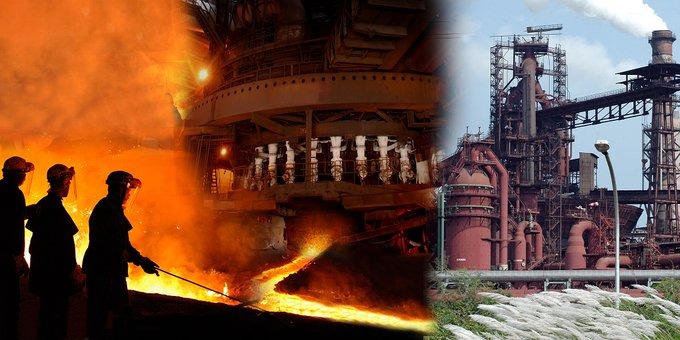Do Not Go For Disinvestment Of RINL, Says People’s Commission On Public Sector And Public Services
RINL is the only steel CPSU without a captive iron ore mine, says the body

The Central Government has put RINL’s 6.3 MTPA capacity steel plant at Visakhapatnam (with its subsidiary, Eastern Investment Limited) on the anvil of disinvestment and is planning to issue an expression of interest shortly. It is a part of the sweeping, indiscriminate disinvest programme announced by the Finance Minister in her Budget Speech of 2021 and formally translated into action through DPE’s guidelines vide DPE/3(1)/2021 DD dated 13-12-2021.
About RINL:
RINL is a Navratna CPSU. From the Public Enterprises Survey of 2020-21, we find that RINL, with its workforce of 16,830 employees, is the 21st largest CPSE employer in the country. It owns 21,713 acres of freehold lands, after the government carved out around 2,000 acres from its original land holding and alienated the same at a highly concessional price to the privately-owned Gangavaram Port. The value of RINL’s land assets at today’s market price is more than Rs 1,50,000 crores. RINL employs 7,152 SC/ST/OBC employees among whom 2,437 (34%) are in managerial positions. RINL made a contribution of Rs 1,885 crores by way of tax and other payments to the public exchequer in 2020-21. Its foreign exchange earnings during the year, through exports, were equivalent to Rs 4,100 crores and the CPSU procured inputs valued at Rs 618 crores from MSMEs, constituting 29% of the total procurement.
Over the years, RINL and its employees, have contributed significantly in contributing to R&D and innovation, corroborated by the large number of patents, both domestic and international, earned by them. During 2020-21 itself, RINL earned six patents.
CPSUs like the RINL serve the purpose of promoting self-reliance in steel and setting benchmarks for efficiency and corporate social responsibility for their private sector counterparts.
RINL’s financial problems:
RINL is the only steel CPSU without a captive iron ore mine, as a result of which it is forced to buy ore at high prices, which has eroded its profitability, year after year. As a result, it has accumulated a huge debt that needs to be redeemed once for all, for it to play its expected role.
Despite repeated appeals made by RINL to the Ministry of Mines, the latter has not chosen to allot the company a captive mine, though the same Ministry continues to shower largesse on private companies by allotting them captive mines without any hesitation. It is ironic that the Ministry of Steel should, instead of securing a captive good-quality iron ore mine for RINL, allow large quantities of iron ore to be mined and exported to other countries, especially China, with whom India has continuing border problems. It is equally ironic that the Ministry of Steel should acquiesce in several unethical private miners exporting iron ore overseas at under-invoiced prices, evading taxes, a fact that came to light in the report released by Justice M B Shah Commission, set up by the UPA government in November 2010 to enquire into irregularities in iron ore mining.
The factors responsible for RINL’s financial problems are beyond the control of its management and the solutions lie with the Centre. Unfortunately, instead of recognising the crucial role of RINL in promoting self-reliance in the field of steel and working towards its revival, the Centre is trying to wash its hands off by resorting to the easy way out by privatising it. Such a measure is neither legally permissible nor financially prudent.
Legal impediment to privatisation of RINL:
We feel that the Centre’s decision to privatise RINL is based on an inadequate application of mind.
For example, the land (21,713 acres) presently under RINL’s occupation was acquired by the State government half a century ago under the erstwhile land acquisition legislation. Under that legislation, land could be acquired only for a “public purpose”, a term legally valid, only as long as the land is used by a corporate entity wholly owned and controlled by the government. If the ownership of the company were to be transferred to a private agency, the original acquisition proceedings would stand null and void. In other words, privatisation of RINL would be legally unsustainable. Even if there is surplus land available with RINL, once RINL slips into the hands of a private agency, it should revert to the State government. In other words, it would be patently illegal for the Centre even to monetise RINL’s surplus land, as is being presently proposed, leave alone privatising RINL.
The Commission is constrained to observe in this connection that the Centre is either oblivious of this legal constraint or it has ulterior motives in privatising RINL.
Public sentiments:
The demand for a steel plant at Visakhapatnam started with a public agitation in the early ’60s and turned violent around 1966. Several people lost their lives in the agitation. When the matter came up before the Parliament, seven Lok Sabha members from AP offered their resignations, when the Centre initially rejected the demand. Finally, the Centre had to accede to the demand and made a statement in the Parliament to that effect. RINL was consequently incorporated as a CPSE to set up the steel plant, the work on which was formally set in motion on 20-1-1971. The State of AP acquired vast stretches of land for the plant, assuring the landowners that the plant would be exclusively in the public sector and that they would get employment benefits. Though the steel plant has provided regular employment to 16,830 persons and indirect employment through a huge supporting industrial complex that has sprung up all around, the assurance given, that at least one member of every family whose land was taken would get a regular job in the steel plant, is yet to be fulfilled in many cases.
RINL, as a CPSU, has since become the hub of a large complex of industrial development that has taken place in north Andhra and has become an integral part of the development of the region. RINL cannot, therefore, be treated as a commercial entity that the Centre can casually and unilaterally hand over to a private group. The local people are important stakeholders and they were never taken into confidence by the Centre, when it took a decision to privatise it. The Centre’s move has, as expected, has evoked an angry response from the people of Visakhapatnam. The Commission expresses its distress at the manner in which the Centre has taken such a summary decision to privatise RINL, without a prior consultation with the State government, without taking the people of north AP in confidence and without considering the views of the large workforce of RINL.
No wonder that a team recently deputed by DIPAM and the Ministry of Steel to visit the steel plant and make an assessment of its viability could not even enter the premises, as it stands cordoned off to keep away the agitating workers, the land oustees and several other civil society groups.
Centre’s muddled disinvestment policy:
The fact that the government’s approach to privatisation of the CPSEs, including monetisation of their assets, continues to be muddled, is best illustrated by the disjointed but highly motivated moves made by it in the specific case of RINL.
The National Steel Policy notified by the Steel Ministry vide GSR 452(E) dated 8-5-2017 stated that “the (steel) CPSEs will… be encouraged to take leadership role in development of steel industry & the community, adopt a more inclusive business model, increase their CSR spends, invest in R&D for indigenous design & engineering and product development for replacement of import. Further, CPSEs will also be encouraged to take lead in promoting steel usage through developing steel intensive structural designs for roads, railways, bridges, crash barriers etc. with proper technical consultations and setting up of service centres for more customised and de-centralised product delivery”. Thus, the Centre’s decision to privatise RINL runs counter to its own publicly enunciated policy.
The disinvestment guidelines stipulate that a transparent procedure should be adopted in calling for bids for a given CPSU, though the guidelines themselves have precluded other CPSEs from bidding, thus restricting competition to a considerable extent. In the specific case of RINL disinvestment, there have been a few questionable developments that have taken place, that suggests an underlying attempt on the part of the Centre to hand over the CPSE to a pre-determined business group, without adequate competition, as indicated below.
- The Steel Ministry persuaded RINL to sign an MOU with POSCO, a South Korean company, on 23-10-2019, for setting up a 50:50 Joint Venture, to install a new steel plant with 7-10MTPA capacity within RINL’s premises. The MOU contained a contentious international arbitration clause and also a regressive confidentiality clause, requiring RINL to keep the contents of the MOU confidential, a clause that is unheard of in the case of any CPSE till now. An RTI activist could somehow extract a copy of the MOU from a reluctant Steel Ministry, to bring those contentious clauses to public notice. Meanwhile, it is rumoured that a favourite private business conglomerate had already got in touch with POSCO to tie up a joint partnership to set up a new steel plant adjacent to the existing one.
- There were public concerns when around 2000 acres of land originally acquired for RINL were handed over to a private promoter decades ago to set up a port near Gangavaram, which literally committed RINL to becoming dependent on the privately operated Gangavaram port, instead of using a Visakhapatnam Port Trust’s public sector port nearby. More recently, both the Centre and the State government tacitly allowed the Adani Group to acquire majority ownership and control over Gangavaram Port, which gave a clear advantage to the Adani Group as a prospective bidder for RINL.
- In addition to crippling RINL’s finances by not allotting a captive mine, the Ministry of Steel has allowed several senior managerial positions in RINL to remain vacant, thereby weakening the CPSE further, perhaps making it easy for the Centre to hand it over to a chosen private group at a price far lower than its intrinsic value.
These are all matters that have serious public interest implications that need to be subject to a discussion in the Parliament and among the public. In our view, privatisation of RINL is legally unsustainable. Centre’s failure to consult the State violated the spirit of federalism. Selling RINL to a private company and monetising its highly valuable land assets would not only be legally impermissible but also it would amount to a breach of public trust. Considering that RINL’s activities are inextricably interwoven with the development of the northern region of AP, its privatisation hurts the public sentiment, which the Centre ought to respect.
Moreover, RINL is a public sector entity that owes its existence to Article 19(6)(ii) of the Constitution. Under Article 12, it is deemed to be an arm of the State. As such, it has obligations under Articles 15 & 16 (reservations for SCs/STs/OBCs) and other obligations as set out in the Directive Principles. The State cannot absolve itself of such obligations by privatising RINL.
Instead of rushing ahead with privatisation, we therefore feel that the Centre ought to proceed on the following lines:
- There is an urgent need to revive RINL’s finances and strengthen its management. A comprehensive revival plan needs to be put in place for this purpose.
- Debt redemption through budgetary support is an essential component of such a revival plan. The Centre could argue that it cannot extend budgetary assistance to RINL due to its own fiscal constraint. Such an argument is not valid as the Centre can always trim many non-productive items of expenditure and also raise additional resources by increasing taxes on the more affluent sections, which is desirable from the point of view of reducing income inequalities and containing a concentration of wealth, in line with the obligations stipulated in the Directive Principles.
- The Centre has recently introduced a scheme for providing subsidies to private industry. As a part of that scheme, it has decided to extend subsidies to cover 50% of the project cost of semiconductor fabrication plants. In the specific case of the Vedanta-Foxconn fab unit being set up in Gujarat, this would imply a subsidy amount of Rs 75,000 Crores. To the best of our knowledge, in independent India, this is the first time that the Centre has decided to provide such a massive subsidy to a private company, that too for a unit that may not be adequately competitive, especially at a time when, in the guise of raising additional fiscal resources, it is selling away its own valuable CPSE assets. In our view, such mindless subsidies to private companies should be done away with, as they are counter-productive. Instead, the resources saved should be earmarked for reviving a CPSE like RINL.
- As a part of the revival plan, the Centre should immediately allot to RINL, a captive iron ore on priority. This will enable RINL to become competitive.
- RINL’s management should be strengthened without delay.
- The Ministry of Steel should review the iron ore export policy and progressively reduce iron ore exports. The Ministry’s effort should be to ensure that iron ore locally extracted is processed to the maximum extent in domestic steel plants and surplus value-added steel products alone are exported. The Centre’s approach to privatisation of the CPSEs and monetisation of CPSE assets is based on fallacious arguments, which do not subserve the public interest. Such mindless privatisation has long-term national security implications. We appeal to the government to drop the same.




